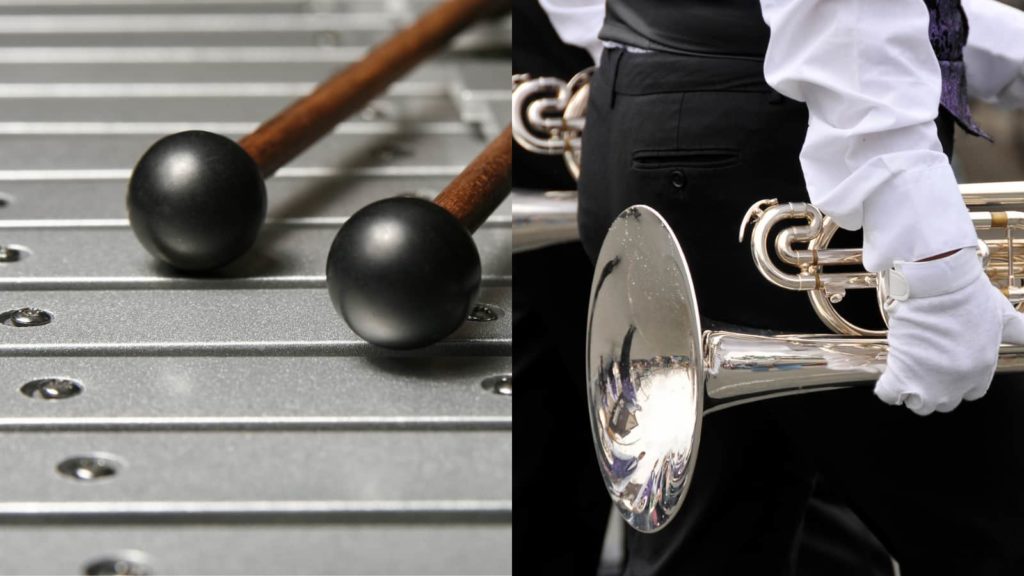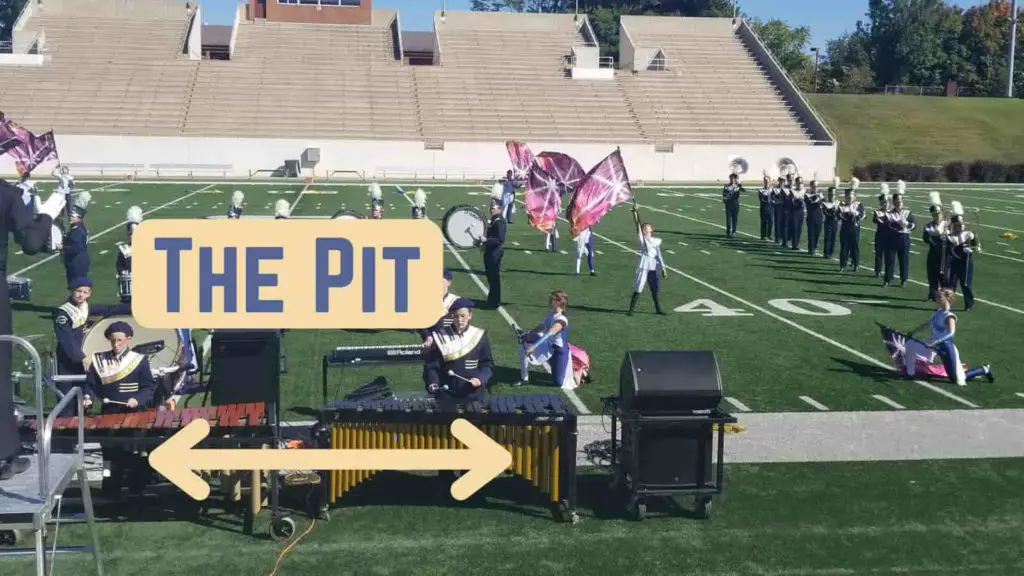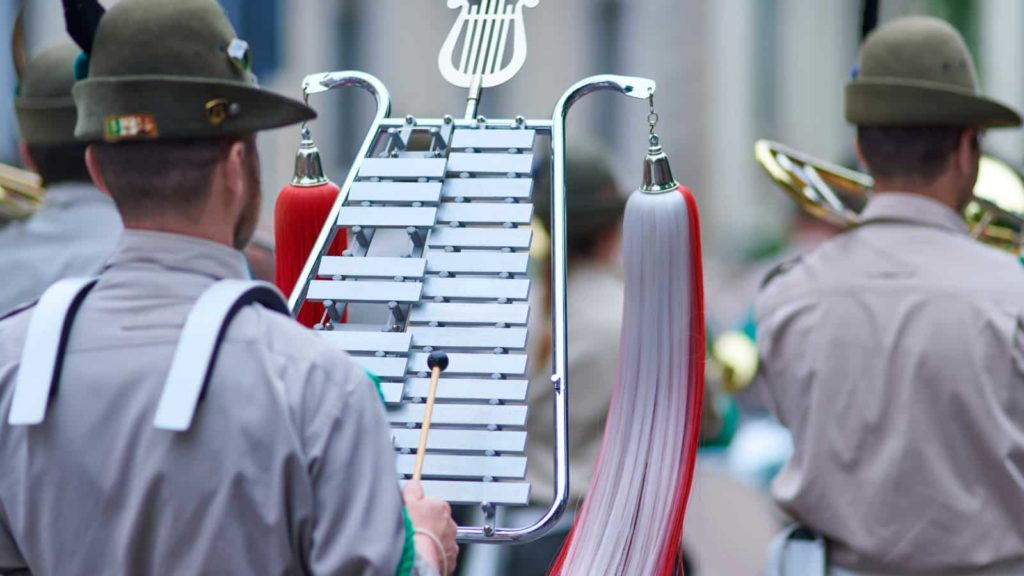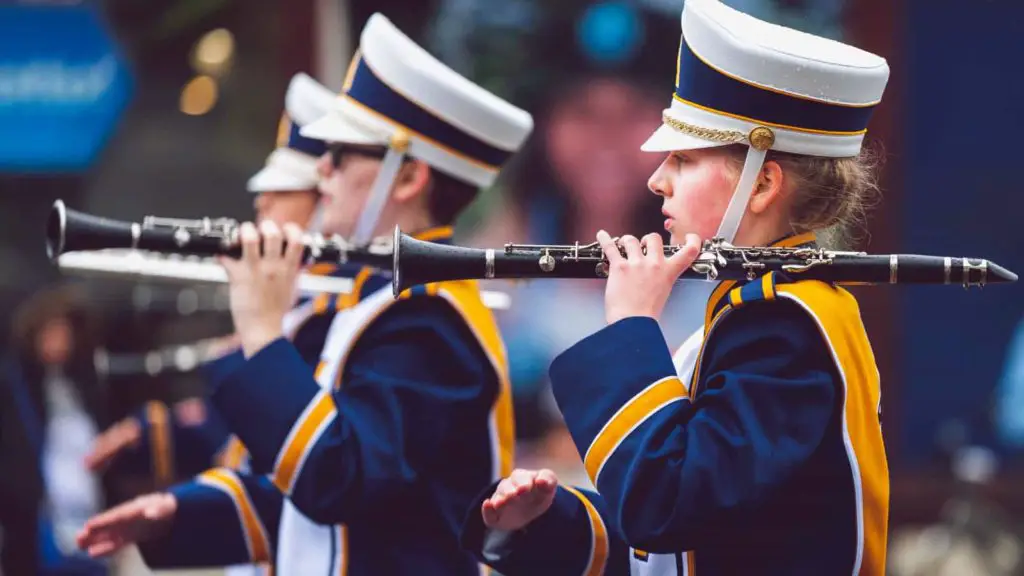If you are new to the Marching Band world you might have heard the conductor or member of the band refer to the bells when talking to his percussion players, then again when talking to his brass players. This is very confusing for some people.
So what are bells in marching band?
The word “bells” has two primary meanings in the marching band world. One meaning refers to the highest metal mallet percussion instrument such as the glockenspiel, and the other refers to the large flare opening of a brass instrument.

You might also think of sleigh bells, jingle bells, the Liberty Bell, and other related words; all of these bells also fall into the percussion category as they produce a sound by striking the bell and hearing audible sound waves from the instrument. The main examples for marching band however have to do with mallet percussion and brass instruments.
Keep reading to learn the difference between all the types of bells you will find in the marching band.
Mallet Percussion Instruments
Mallet percussion instruments are made of rectangular bars, each bar being a different length affecting how high or low the pitch is. They produce a sound by striking a mallet made of metal, plastic, yarn, or other materials on the rectangular bar.
Bells are one example of mallet percussion instruments. Other examples of common mallet percussion instruments include xylophone, marimba, and vibraphone.
The bars of the mallet percussion instruments are commonly made of metal, wood, or synthetic material giving them various tones. These instruments are typically played in the pit of the marching band.

The Pit in Marching Band
Bells referring to the mallet percussion instrument are typically played in the pit.
The pit is the ensemble of musicians on the front sideline who do not march but primarily focus on playing mallet percussion instruments.
Pit musicians can also cover auxiliary percussion instruments that are difficult to march with on the field, or would be difficult to hear from further away.
Bells in the pit are high-pitched mallet percussion instruments with metal bars. They can also be called glockenspiels. Mallet percussion instruments that are played in the pit can cover a wide range of notes.
Marimbas and xylophones, in particular, can easily cover four octaves whereas standard bells usually cover 2.5 octaves. The main difference is the bells cover a much higher register and have their characteristic metallic tone.
One of the most impressive aspects of pit musicians is the technical precision required. In most cases, members of the pit must cover multiple instrument parts throughout the show. Bells might be one of the instruments they play, but members will likely switch to different mallet or auxiliary percussion instruments throughout the field show.
Marching Bells and Bell Lyres
Some bands actually have band members march on the field with bells or other mallet percussion instruments, but these types of instruments are smaller and worn with a harness.

Some marching bells or glockenspiels can also be held vertically rather than horizontally on a harness; these are called bell lyres. Below are links displaying newer horizontal marching bells with a harness as well as the older bell lyres that can be played vertically. Marching bells on the field are more uncommon these days in most marching bands, especially the vertically played bell lyres.
Top Tip: You can check out Marching Bell Lyre and a carrier and harness here. These ones are really good quality and will last your Marching band for many years.
Video Example- DCI Carol of the Bells over the years
Below is a video of various Drum Corps International groups playing Carol of the Bells-themed shows. At the beginning of each clip, you can hear the high-pitched metallic tone of the bells playing familiar themes.
The first group in the video is Carolina Crown from 2003 followed by the Cadets in 2012. The next example in the video is Seattle Cascades from 2014, followed by Southwind in 2015. Each video clip includes the characteristic sound of the bells.
Brass Instrument Bells
Bells can also refer to the large flared opening at the front of brass instruments. These bells help the sound project out into the audience, giving marching bands their characteristic “brassy” sound.
Brass instrument sound is directional meaning that the sound comes from the opening of the bell. Sometimes, brass players face away from the audience on the field to make the sound quieter, then turn to face the audience to make the sound louder.
While brass bells all have the same purpose, they can vary greatly in size. Higher-pitched brass instruments such as a trumpet have smaller bells. Lower pitched instruments such as a tuba have larger bells.
There is also a difference in the bore or the shape of the tube making up the brass instrument. Brass instruments can have a cylindrical bore, which generally stay the same size until the bell. Other instruments have a conical bore, which expands gradually up to the bell.
Trumpet and trombone for example have cylindrical bores; the sound is brighter and more direct. Mellophone and tuba have conical bores; the sound is smoother and warmer.
The image on the left is a trumpet; notice how the metal tube stays generally the same size throughout until the bell expands at the end. The bell is also relatively small. | The image on the right shows a marching euphonium and tuba, both with large bells and conical bores. Notice how the tube expands wider throughout the instrument. |
High Brass Instruments
Here are examples of high brass instrument features from Drum Corps International over the years. Observe the size and shape of the bells compared to the sound the instruments produce:
Low Brass Instruments
Here are examples of low brass instrument features over the years. Observe how the contrast in size and shape of the bells alters the sound the instruments produce:
Below is a chart displaying standard bell sizes of various brass instruments.
Chart of Brass Instrument Bell Sizes
| Trumpet | Mellophone | Trombone | Euphonium | Tuba |
| 4.5 inches | 7 inches | 8.5 inches | 11-12 inches | 18-20 inches |
Bell Covers
Following Covid-19, emerging research started to come out about the spread of aerosol when playing band instruments. Studies found that wearing a bell cover helped reduce the spread of aerosol, especially when playing indoors.
Many band programs started requiring the use of a bell cover to help reduce the spread of Covid-19. A bell cover is circular in shape and covers the brass bell, similar to using a face mask but for brass instruments. Bell covers are made of a variety of materials such as polyester and spandex.
Musicians also needed specially designed instrument masks allowing band members to play their instruments while still adhering to mask safety requirements. With an increased demand for bell covers and instrument masks, music suppliers dedicated more energy towards keeping up with the emerging changes.
Here is a link to Woodwind Brasswind, a common supplier of band instruments and additional accessories such as bell covers. Bell covers come in a variety of sizes, each one correlating to the brass instrument bell size. The material fits securely over the bell and can be adjusted to each specific instrument.
Woodwind Instruments
Some woodwind instruments also have bells such as clarinet and saxophone though the function of the bell has less of an impact on the sound compared to brass instruments. Emerging research found less of an impact on bell covers with woodwind instruments as particles can come from individual keys as well as the bell.

This being the case, some manufacturers created instrument bags with holes for hands and mouthpieces to go through. The instrument can go inside the bag and band members play their instrument while it is covered. Emerging research was also inconsistent if this significantly reduced the spread of aerosol, especially when playing outdoors, so in most cases, they are not used.
Instrument Masks
In addition to bell covers and woodwind bags, there are specific masks that can be used with each instrument. As mentioned earlier, each different type of mask allows the unique mouthpiece of the instrument go through the masks to the player’s mouth, allowing them to play their instrument while adhering to mask guidelines.
Here is a link to view various types of instrument masks on Woodwind Brasswind. They all generally look the same, with the exception of the flute, as the head joint needs more space.
The flute does not require a player to put a mouthpiece into the player’s mouth like other instrument mouthpieces. The shape and size of the flute masks reflect the change.
Summary
Overall, the word bell can refer to many different things, but generally within a marching band setting, it will refer to either mallet percussion instruments or the large flared opening at the end of a brass instrument.
The mallet percussion bells cover the highest range of pitches within the ensemble and are made from metal, giving them a characteristic sound. The sound can be heard from very far away, though mallet percussion bells in marching bands typically are played in the pit at the front of the ensemble.
Bells referring to the large flare at the end of brass instruments help the sound project out into the audience. This allows marching bands to play at high volume even when outside in a football stadium while spread out across the entire field. The size and shape of the bell affect the sound, allowing bands to play with a variety of tones during their field show.
We hope this article answers all of your questions about what bells are in marching band. Let us know in the comments if you have any other questions about bells or share any new information you learned from our page! Thank you for visiting Top Music Tips!
Up Next:
Flute Versus Saxophone: Which is Easier to Learn?
Marching Trombone vs Flugabone (Your Complete Guide)
Disclaimer: This post may contain affiliate links. We only recommend high-quality products that are used and recommended by real musicians. If you use these links to buy something we earn a small commission.
